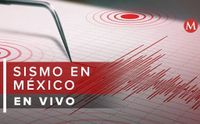As Mexico continues to grapple with its seismic reality, the National Seismological Service (SSN) reported a series of minor earthquakes early on Friday, May 9, 2025. These tremors, which are part of the country’s frequent seismic activity, were felt across various regions, underscoring Mexico's position on the Pacific Ring of Fire, an area known for its high seismic activity.
At 4:38 AM, a magnitude 3.5 earthquake struck 13 kilometers south of Pinotepa Nacional, Oaxaca, followed shortly by a 1.9 magnitude tremor at 4:44 AM, located 8 kilometers southwest of San José del Cabo, Baja California Sur. This was followed by another minor quake of magnitude 1.8 at 4:49 AM in the same vicinity.
Just minutes later, at 4:51 AM, a magnitude 3.1 earthquake occurred 14 kilometers southeast of Ometepec, Guerrero, and at 4:54 AM, a 3.8 magnitude tremor was recorded 4 kilometers northeast of Salina Cruz, Oaxaca. These small quakes are part of a larger pattern, as Mexico experiences over 90 earthquakes each year with a magnitude greater than 4 on the Richter scale, accounting for approximately 60% of the world’s seismic activity.
Mexico’s geographical positioning makes it particularly susceptible to earthquakes. The country is situated atop five tectonic plates: the North American, Cocos, Rivera, Pacific, and Caribbean plates. The interaction among these plates results in frequent seismic activity, with certain states like Jalisco, Colima, Michoacán, Guerrero, Oaxaca, Puebla, State of Mexico, and Veracruz being at a higher risk for significant earthquakes.
In light of these recent seismic events, the SSN emphasizes the importance of preparedness. The organization provides guidelines on how to respond during an earthquake, such as staying calm, seeking shelter under sturdy furniture, and avoiding the use of elevators. Additionally, the SSN recommends that individuals keep an emergency backpack ready, stocked with essentials like water, non-perishable food, a flashlight, and important documents.
On a broader scale, the United States Geological Survey (USGS) has highlighted the risk of earthquakes in the U.S., noting that nearly 75% of the country may experience damaging earthquakes in the future. The West Coast, particularly California, Alaska, and Hawaii, is most at risk due to its proximity to the Pacific Ring of Fire. Major cities like San Francisco, Los Angeles, and Seattle are situated near significant fault lines, making them vulnerable to seismic events.
Interestingly, the Richter scale, historically used to measure earthquake magnitudes, has been largely replaced by the moment magnitude scale, which provides a more accurate measure of the energy released during larger quakes. This shift reflects advancements in seismology and the need for more precise data in understanding seismic events.
In Mexico, the SSN utilizes a network of sensors primarily located along the Pacific coast and in the Neovolcanic Axis to monitor seismic activity. This network is crucial for providing timely alerts to the population, particularly in major urban areas like Mexico City, where the risk of severe earthquakes is heightened.
Despite the advancements in monitoring and preparedness, the unpredictability of earthquakes remains a challenge. As of now, no technology can accurately predict the exact time or location of an earthquake. This uncertainty reinforces the need for ongoing education and preparedness among residents in seismically active areas.
As the day progressed on May 9, 2025, the SSN continued to monitor seismic activity, ensuring that the public remained informed about any significant tremors. The agency’s commitment to transparency and timely reporting is essential in a country where earthquakes are a part of life.
In summary, the seismic activity recorded on May 9 serves as a reminder of Mexico's geological realities. The country’s location on the Pacific Ring of Fire necessitates a constant state of vigilance and preparedness among its citizens. As the SSN reports, understanding the nature of these movements and having a plan in place can make a significant difference in ensuring safety during seismic events.





